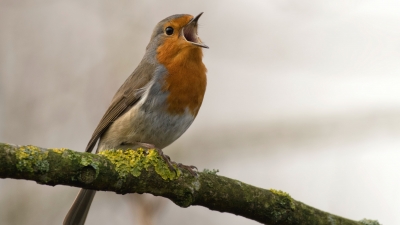
Songbirds rehearse their melodies by ‘singing in their sleep’. Scientists believe that the birds dream of singing to help them hone a range of different tunes. Young birds learn to sing by listening to adults and then practise by listening to their own attempts. Research suggests that songbirds store a song after hearing it, then rehearse it later in their sleep.
The researchers compared the activity of each neuron while the awake bird sang, while a sleeping bird could hear a recording of its own song, and during undisturbed sleep.
While the birds are awake and singing the neurons fire in a pattern that is unique to the note and syllable components of each bird’s individual song. When the awake bird hears its own song, these neurons do not fire in response.
But in the sleeping bird listening to a recording of its own song, the neurons do fire in the pattern identical to song production, though the bird produces no sound. This pattern of firing during listening, like the pattern of firing necessary to produce song, actually anticipates the next song “syllable,” or set of notes.
“The learned song is a temporal code that uses the nerve impulse spikes of single cells in precisely matched patterns for hearing and singing. The two patterns can be ‘mapped’ to each other with spike-by-spike precision,” said Margoliash. “The bird is using the preceding sound to predict how to generate the next syllable.”
Understanding how patterns of behavior are represented in the brain has been a major problem for neurobiologists.
“Previously we found that during singing song is represented as a temporal code. Now, much to our surprise, we find this correspondence in single cells of matched sensory and motor patterns. Forming this mapping of sound and action is the process of learning,” said Margoliash.
During undisturbed sleep, the researchers discovered, the neurons spontaneously fired the same complex song production patterns in bursts. Interestingly, these activity patterns were at slight variance, as if the bird was rehearsing a variety of slightly different songs, sometimes with slower or faster tempos.
How does the bird learn to correct its song when by the time it hears it the neuron is now engaged in the production of the next sound? Practice during sleep may be part of the answer.
“In contrast to the prevailing idea that it learns by making moment-to-moment adjustments, we think the bird stores the song production pattern and reads it out at night, an ‘offline’ solution to the timing problem,” said Margoliash. “The zebra finch can replay and strengthen the pattern during sleep.”
The next step, according to Margoliash, is to explore what happens to song learning when the sleep replay is interrupted.
“If we can describe the rules by which sleep acts on song learning, these lessons may apply to learning in other animals, including humans,” said Margoliash. “Neurobiologists have often found that lessons learned from weird and wonderful animals apply to all animals. The beautiful songs of birds could have much to teach us about how we learn.”
Credit : Science Daily
Picture Credit : Google




